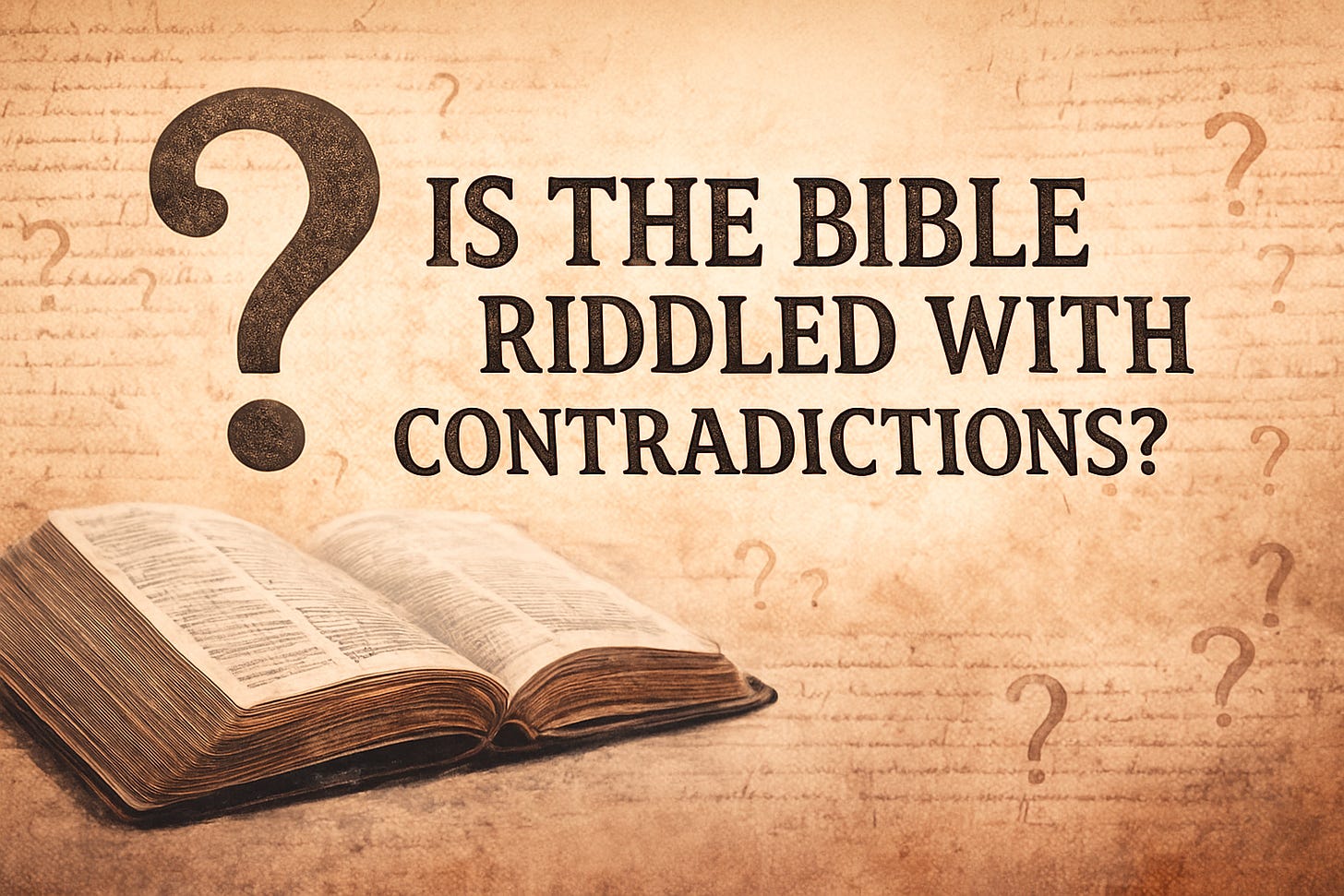Is the Bible Riddled with Contradictions? A Good Faith Examination
“The Bible is riddled with contradictions.” It’s a common claim: confident, dismissive, and rarely examined. But is it accurate?
The short answer: it conflates two different things. Tensions that require interpretive work are not the same as strict logical contradictions. The distinction matters.
What Counts as a Contradiction?
A strict logical contradiction occurs when two claims cannot both be true under any coherent interpretation. If I say “the door is open” and “the door is closed” at the same moment referring to the same door, that’s a contradiction. No possible scenario resolves it.
A tension or apparent discrepancy is different. Two accounts may seem to conflict while remaining logically compatible. Perhaps they describe different aspects of the same event, use different conventions, or one provides details the other omits.
The question isn’t whether the Bible contains passages requiring interpretive work. It does. The question is whether any of them meet the stricter standard: no possible reading makes both claims true.
Testing the Common Examples
Critics typically cite a handful of passages. Let’s examine them.
Noah’s Animals
Genesis 6:19-20 instructs Noah to bring two of every kind onto the ark. Genesis 7:2-3 says seven pairs of clean animals, one pair of unclean. Contradiction?
No. The first passage gives the baseline instruction. The second adds specificity. The additional clean animals serve a purpose: Noah offers a sacrifice in Genesis 8:20. If he only had one pair of clean animals and sacrificed them, the species would be extinct. This is clarification, not contradiction.
Judas’s Death
Matthew 27:5 says Judas hanged himself. Acts 1:18 describes him falling headlong and bursting open. Two different deaths?
Not necessarily. These can be sequential events: death by hanging, followed by the body falling, whether by the rope breaking, decomposition, or being cut down. It requires filling in unstated details, but nothing in either text excludes the other. A contradiction would require that both accounts cannot be true. Here, both can be true.
Goliath’s Killer
This one appears more troubling at first glance. 1 Samuel 17 clearly states David killed Goliath. But 2 Samuel 21:19 seems to say Elhanan killed Goliath. Two different people killing the same giant?
Look closer. 1 Chronicles 20:5, the parallel passage, clarifies: Elhanan killed Lahmi, brother of Goliath. The 2 Samuel text shows signs of scribal corruption: name-mixing, term duplication, garbled phrasing. This is routine textual transmission, the kind of copying error scholars see in ancient manuscripts constantly.
David killed Goliath. Elhanan killed Goliath’s brother. The texts aren’t contradicting each other; one preserves the accurate reading, and one preserves a corrupted transmission of it.
The Pattern
Notice what’s happening in each case. The tensions are real. I’m not pretending the text reads smoothly without any effort. But “requiring interpretive work” differs from “logically impossible to reconcile.”
Most alleged contradictions follow this pattern. When examined, they resolve through context, genre considerations, complementary perspectives, or recognizing transmission realities. Some resolutions are more elegant than others. But the bar for “contradiction” is that no possible scenario makes both claims true. That bar is rarely if ever met.
The Transmission Reality
Here’s where some Christians get uncomfortable, and they shouldn’t.
The Bible is a transmitted document. Human authors, working across centuries, composed texts that were then copied by hand for millennia before the printing press. Scribal errors occurred. Variants exist. This is simply historical reality.
But this doesn’t undermine inspiration. It clarifies what inspiration means. Scripture presents itself as human authors collaborating with the Holy Spirit, not as divine dictation dropped from heaven. Paul’s letters sound like Paul. Jeremiah’s prophecies carry Jeremiah’s personality. The human element is not a bug; it’s a feature.
Consider the alternative. If we possessed a physically perfect text (unchanged, unchallengeable, miraculous in its preservation) what would we do with it? Based on human nature, we would likely venerate the object itself. We already struggle with bibliolatry, treating the text as the ultimate focus rather than what it points toward.
Perhaps the transmission reality serves a purpose: keeping our focus on the One to whom Scripture witnesses, rather than making Scripture itself an idol. The Bible’s job is to lead us into truth, specifically to Christ, who is the Truth. A “perfect artifact” might actually obstruct that purpose.
Good Faith Engagement
Good faith means approaching the text without preloaded assumptions about what the authors or scribes intended. It means reading to understand before reading to critique. This sounds obvious, but it’s increasingly rare.
Modern debates and publications often begin with conclusions already in hand. Critics approach Scripture looking for ammunition. Defenders approach it looking for vindication. Neither is reading the text on its own terms.
This cuts both ways.
Skeptics who claim the Bible is “riddled with contradictions” are typically overstating what the evidence shows. They’re identifying tensions and calling them contradictions without doing the work to demonstrate logical impossibility.
Christians who insist no tensions exist are also overstating. The text requires engagement, not just defense. Acknowledging scribal variants and interpretive challenges isn’t a concession. It’s honesty about how ancient documents work.
The job of a good faith textual critic, believer or not, is captured in Paul’s instruction: “Do not treat prophecies with contempt. Test everything, keep the good” (1 Thessalonians 5:20-21).
Test the claims. Examine the evidence. Keep what holds up.
When you do that with the “contradictions” charge, you find tensions that resolve under scrutiny, not a text riddled with logical impossibilities.


